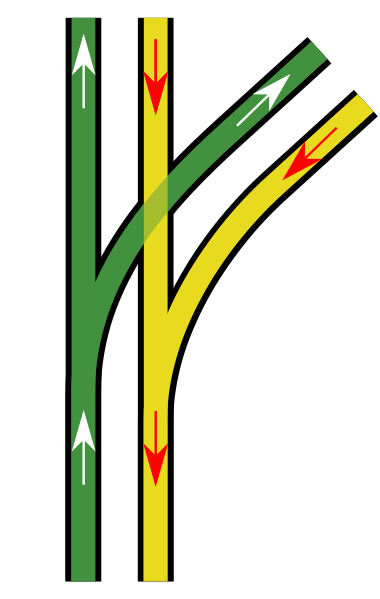A flat junction is where railway line splits into two branches. Such branching at flat junction causes problems when trains operate at high frequencies (due to trains travelling in opposite directions crossing each other's path). This is shown in the diagram below, where the green line crosses over the yellow line.
Added to this complication in the case of the Granville flat junction is that there is sharing of tracks by both the Cumberland Line and the South-Innerwest Line. Given the assumed maximum track capacity of 20tph, the question arises: how will the Inner West operate 20tph into/from the CBD, as well as provide scope for 6+ tph Cumberland line trains between Liverpool and Parramatta, all whilst coping with the flat junction issue?
I am beginning to think it can't and it won't. Instead if it isn't done at the 2019 timetable, then by the time the 20tph Innerwest service becomes operational (post SRT stage 3), the Innerwest to Parramatta local will operate with high frequencies in only one direction, and will have substantially lower frequencies in the other direction (instead, trains from the CBD will predominantly go down the Liverpool branch). Likewise the Cumberland line will only operate predominantly in one direction as well (this is needed to ensure train numbers balance, and there isn't an accumulation of trains at Liverpool, and a deficit of trains at Parramatta). That is train services will look something like the following:
In more detail, services will run as follows:
1. Liverpool to CBD: 6tph in 2019, increasing to ~10tph post SRT (all are peak hour frequencies).
2. Parramatta to CBD: 6tph in 2019, increasing to ~10tph post SRT (all are peak hour frequencies).
3. CBD to Liverpool: 8-12tph in 2019, increasing to 16-20tph post SRT (all are peak hour frequencies).
4. CBD to Parramatta: likely low frequency (0~4tph); passengers going to Parramatta have many services already on Western line, and afternoon peak is less "peaky" than morning peak so capacity issues should be less prominent. This will avoid the flat junction problem where the green tracks cross over the yellow tracks.
5. Liverpool to Parramatta: 6+tph frequency is a possibility.
6. Parramatta to Liverpool: likely few to no services (0~4tph); passengers need to interchange at Granville (via an easy cross-platform change over) onto CBD to Liverpool services. Having a very high (16-20 tph) frequency from Granville to Liverpool will make this a painless interchange and much better than a low frequency direct Cumberland line service, with long wait times.
Point #6 above highlights how misguided the original premise of the Cumberland line was ... without the passenger demand to support a high frequency service, it was never an effective link between Parramatta and Liverpool, as wait times of 15-30 minutes substantially reduce the desirability of the service. Instead, it would be better to put more resources into operating high frequency services through Granville and relying on interchange at Granville.
My prediction is only of modest certainty, as there are other possibilities that I don't rule out:
1. TfNSW upgrade the Granville flat junction into a flying junction
2. Most of the increased frequency is by adding services starting at Homebush or at Ashfield, thus avoiding the whole issue of managing high frequencies at the Granville junction. (Weighing up against this possibility is that stations up to Ashfield, or even Homebush, do not have sufficient patronage to fill up 20 trains per hour, and it is for stations further out where the additional capacity is needed).


No comments:
Post a Comment